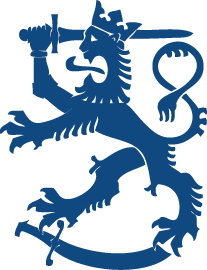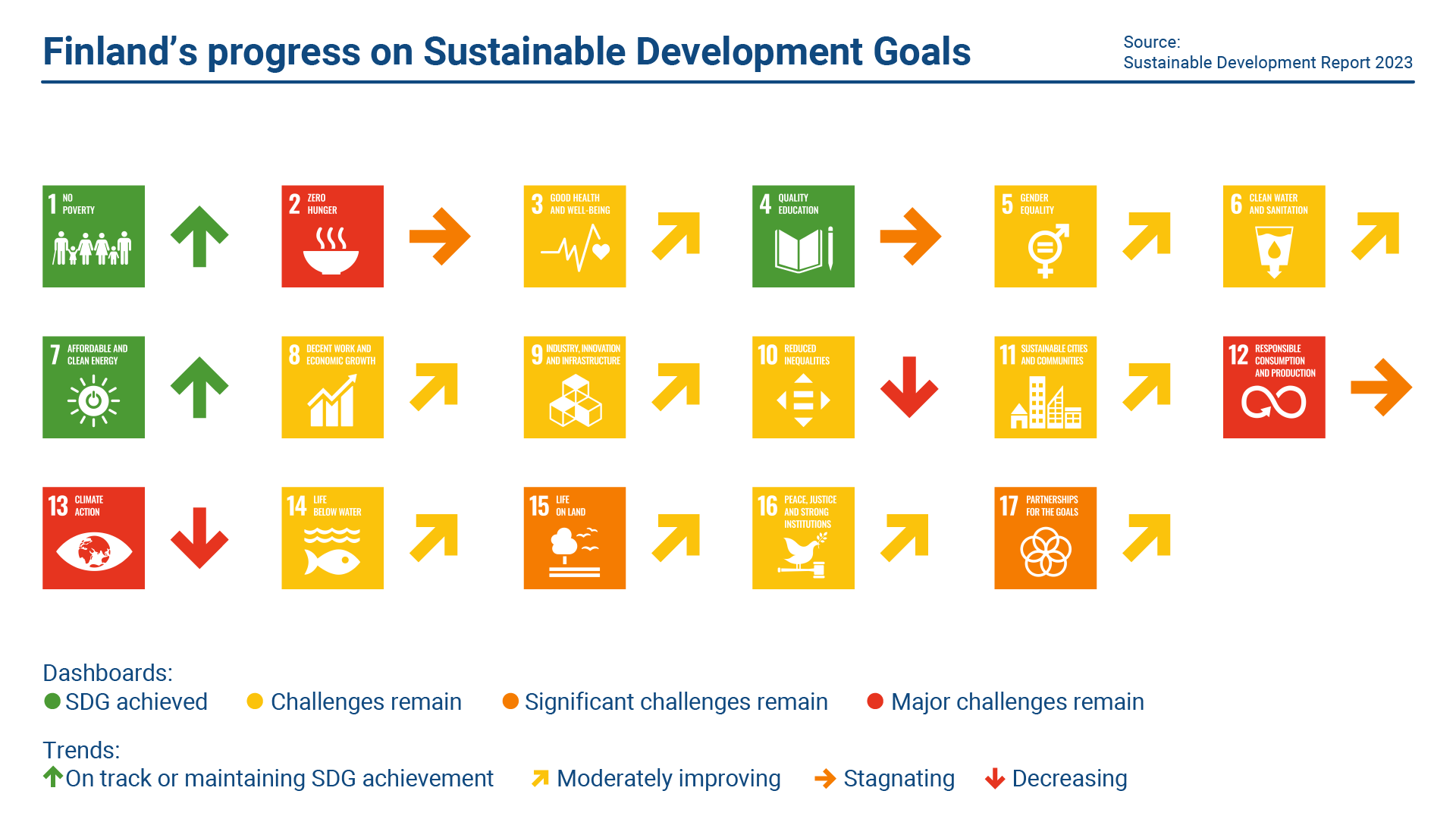Climate targets
Finland’s greenhouse gas emissions are steadily decreasing, but Finland’s goal of becoming carbon neutral by 2035 will require additional measures, especially to strengthen its carbon sinks.
Finland’s climate targets are set by the EU legislation and the national Climate Change Act. Finland’s EU level obligation is to reduce emissions from the effort sharing sector – for example in transport and agriculture – by 50% by 20301. In the EU, the target for the net sink of the land use sector is set by the LULUCF regulation. Under this regulation, the land use sector should cause no net emissions in the period 2021-2025. Furthermore, the minimum net removal level set for Finland’s carbon sink is -17.8 million tonnes of CO² equivalent by 2030.
Finland’s own target under its Climate Change Act is to reduce emissions by 60% by 20302 and achieve carbon neutrality by 2035. Carbon neutrality means balancing Finland’s emissions with its carbon sinks.
As it stands, achieving these goals remains uncertain. Finland’s greenhouse gas emissions are decreasing steadily particularly in energy production and energy-intensive industry due to the EU wide emissions trading system. In the emissions trading sector, it is possible that emission reductions can be achieved even faster than anticipated. However, the carbon sink of the land use sector is far from the target level. The achievement of the Finnish effort sharing sector’s obligation set at the EU level is also uncertain.

Under the national Climate Change Act, Finland’s net emissions should be zero or negative by 2035. By 2030, the total emissions must be reduced by 60% compared to the 1990 level. At the EU level, it has been agreed that the carbon sink of the Finnish land use sector must be -17.8 million tonnes of CO2 equivalent by 2030. Annual Climate Report data for 2022 are based on Statistics Finland’s proxy estimates, which will be specified later. Source: Annual Climate Report 2023
In 2022, Finland’s greenhouse gas emissions decreased by 3% compared to the previous year. According to current estimates, Finland’s emissions reduction trend is in line with the target for 2030. Emissions have decreased by 35% compared to 1990, and by 46% compared to 2003, when emissions were at their highest during the 1990–2022 period. Over the past five years, Finland’s total emissions have decreased by an average of 4% annually.
Finland’s greatest challenge is the carbon sink of its land use sector (LULUCF). According to preliminary data published in December 2023, the land use sector was a net source of emissions in 2022, when its emissions exceeded removals by 4.5 million tonnes of CO₂-equivalent. The size of the forest carbon sink varies substantially from one year to the next, but the sink has declined significantly over the past few years. The weak development of the net sink of the Finnish land use sector is attributable to increased forest harvesting, the slowing of forest growth and the increased soil emissions from peatlands.
Finland’s first climate plan for the land use sector was completed in 2022. It includes various measures for reducing emissions from the land-use sector and strengthening its carbon sinks and stocks.
Emissions from the emissions trading sector decreased by 6% in 2022 compared to the previous year. The share of natural gas in Finland’s energy supply is small and its consumption halved as a result of price increases and the end of Russian imports. In addition to the EU ETS, the reduction of emissions in this sector has been influenced by energy taxation, subsidies for renewable energy, measures to improve energy efficiency, and a law banning the use of coal in Finnish energy production at the start of 2029.
Emissions from the effort-sharing sector decreased in Finland by 3% in 2022. However, emissions from the largest emitters in the effort-sharing sector – transport and agriculture – remained almost unchanged. Emissions from Finnish agriculture have remained at almost the same level since 2005. Transport emissions have decreased by 22% since 2005, and Finland’s goal is to halve them by 2030. One of the most important measures for reducing transport emissions is the distribution obligation for renewable transport fuels. This obligation mandates that fuel distributors must include a certain proportion of renewable fuels in their fuel mixtures. Though the obligation has been temporarily reduced by the recent and current government, it delivers significant emission reductions in the transport sector yearly. The obligation will increase gradually to 34 % by 2030 according to the present legislation.
Under the Climate Change Act, the Government submits an Annual Climate Report to the Parliament each year. The Annual Climate Report examines the general development of greenhouse gas emission trends and the sufficiency of the planned measures in relation to the national climate targets and Finland’s EU obligations.
1 Compared to the 2005 level
2 Compared to the 1990 level
UN Sustainable Development Goals
Finland is a global frontrunner in sustainable development when measured by performance on the Sustainable Development Goals. In 2023, Finland topped the global as well as European SDG Index rankings for the third year running. Yet even Finland faces challenges in achieving all of its goals by 2030.
Finland, along with the other Nordic states, regularly tops international comparisons of sustainable development indicators. This was also the case in 2023, when Finland achieved its third successive #1 ranking among the 166 countries included in the SDG Index comparison, carried out by the UN and the Bertelsmann Foundation. The comparison is an annual assessment of how the countries promote the 2030 Agenda for Sustainable Development and the related Sustainable Development Goals.3
There are 17 Sustainable Development Goals in all. At the moment, Finland has achieved or is close to achieving approximately 60% of these goals, and according to current estimates, it will achieve the majority of the goals set for 2030. Finland has met its goals for poverty reduction, clean and affordable energy, and good education. Finland has also done well in its social sustainability goal and is close to achieving the goals related to gender equality, decent work and economic growth, and peace and the rule of law.
However, even Finland faces challenges in achieving all of its goals by 2030. These challenges are particularly related to ecological sustainability, global responsibility, and adverse impacts across different borders. Of the main goals, SDG 13: Climate Action, SDG 14: Life Below Water, and SDG 15: Life on Land will require the most additional measures from Finland before they can be realised.
In addition to the main goals, Finland’s performance with respect to many of the 169 targets varies. According to Statistics Finland, the most pressing issues for Finland include economic inequality, unemployment and social exclusion, high greenhouse gas emissions per capita, and biodiversity loss. Success in international indicator comparisons correlates with high GDP per capita, as many of the indicators are intertwined with high levels of consumption. In other words, comparisons between countries can, at will, be criticised for the fact that while high GDP per capita guarantees a high level of investment, it can also obscure real and legitimate issues.
According to Jukka Hoffrén, environmental economist and statistician at Statistics Finland, another deficiency in the indicators is that the environmental well-being is not yet monitored in a balanced manner when compared to economic and social well-being. The set of SDG indicators lack important environmental factors: for example, Finland’s two main objectives – achieving carbon neutrality by 2035 and the EU biodiversity strategy’s 30% nature conservation target for 2030 – are not included in the monitored indicators. Achieving these objectives will require systemic changes over a long period of time, and they must be solved locally using efficient local policy measures, such as national legislation in the case of Finland’s carbon-neutrality target.
Global progress on the SDGs has bogged down in the 2020s. The foreboding message of the interim review of the targets set in 2016 was that the signatories had strayed dramatically from the intended path for sustainable development. In addition to the prolonged impacts of COVID-19 pandemic, the climate crisis, the Russian invasion on Ukraine, and the generally weak growth of the global economy have halted global developments to the level measured in 2019. According to current development trends, only 15% of the 2030 Agenda will be achieved globally.
3 The comparison was made using 97 global indicators, as well as 27 indicators that were only applied to OECD countries. There are a total of 247 SDG indicators, so the comparison does not take into account all aspects of sustainable development.
Finland and ESG
- The State Treasury’s approach to sustainability is holistic. Focusing on government level targets, performance, and recognising the social nature of budget spending.
- The focus of our funding strategy is on the liquidity of the benchmark bond curve, and thematic bonds are currently not part of the strategy.
- Finland is by many metrics a global forerunner in sustainability. For more information on the Finnish government’s sustainability targets, please visit the ESG section on the State Treasury website.
Sources:
- Annual Climate Report 2023, Ministry of the Environment
- Statistics Finland: Greenhouse gas emissions fell in 2022 – the land use sector was a net emission source https://stat.fi/en/publication/cl8a4c4tivtd00bvyvo6fy0sv (14 December 2023)
- Sustainable Development Report 2023: https://dashboards.sdgindex.org/chapters
- Sustainable Development Goals: Progress Chart 2023: 2023 SDG Progress Chart 0910 (un.org)
- Biodiversity: How the EU protects nature Biodiversity: how the EU protects nature – Consilium (europa.eu)


